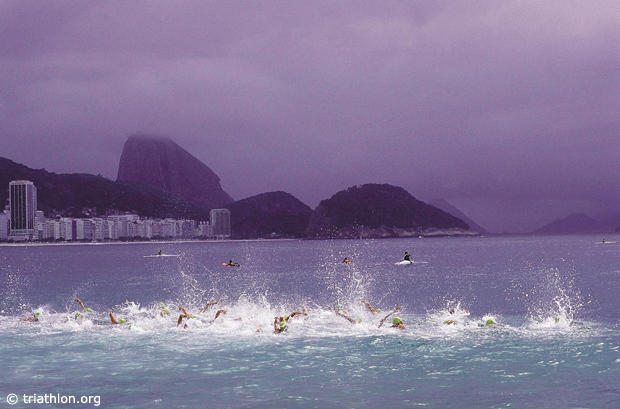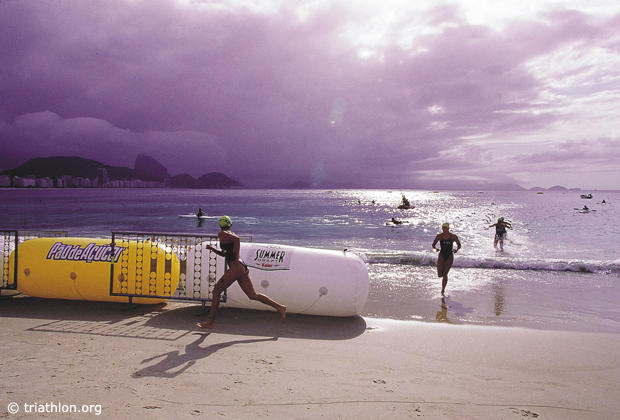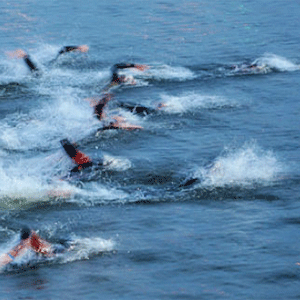Is Rio’s Water a Lab Experiment?
The timing couldn't be worse. Many of the world's top triathletes are in Rio de Janeiro, assembled for the Rio Test Event. This will be a dress rehearsal for the 2016 Olympic Games, held on the Olympic course, and acts as an Olympic qualifier for a number of countries. It's part of the International Triathlon Union's (ITU's) 2015 schedule of races and it's a big deal, probably second only to the Grand Final in importance for Olympic-style triathletes.
The triathlon world awoke today to an article published by the Associated Press (AP) that was alarming: "An AP analysis of water quality revealed dangerously high levels of viruses and bacteria from human sewage in Olympic and Paralympic venues — results that alarmed international experts and dismayed competitors training in Rio, some of whom have already fallen ill with fevers, vomiting and diarrhea."

And, "…the stench of raw sewage still greets travelers touching down at Rio's international airport. Prime beaches are deserted because the surf is thick with putrid sludge, and periodic die-offs leave the Olympic lake, Rodrigo de Freitas, littered with rotting fish.
"The AP viral testing, which will continue in the coming year, found not one water venue safe for swimming or boating, according to global water experts," continued the article.
Is this true? And it is a fair representation of the quality of the water venue for the race this weekend?
The article wrote that "75 percent of the samples taken at the Olympic lake, the number of fecal coliforms exceeded Brazil's legal limit for ‘secondary contact,' such as boating or rowing," the AP article said. "…in two samples spiking to over 10 times the accepted level." But a close read of the article tells us, "At Copacabana, the AP tests found no violations of fecal coliform counts."
This is the venue where triathlon and open water swimming will take place in the Olympics.

One of the article's main themes was criticism of the testing protocol used for the Rio Games. Rio tests for bacteria but not for viruses. The AP testing consisted of fecal coliform plus three different types of human adenovirus, enteroviruses and rotavirus. Viral contamination is where the AP maintains that triathletes could be at risk. "The concentrations of the viruses in all tests were roughly equivalent to that seen in raw sewage — even at one of the least-polluted areas tested, the Copacabana Beach, where marathon and triathlon swimming will take place and where many of the expected 350,000 foreign tourists may take a dip."
The AP article appears critical of Rio's decision not to test for viruses, but in Slowtwtich reporting in years past on water safety it's rare to nonexistent to find a water quality agency testing for viruses. Most agencies rely on testing for escherichia coli (E. Coli) and entero coccus, two kinds of bacteria. These are considered reliable indicators of other, perhaps nastier, germs, including viruses.
The State of California is considered, as states go, on the leading edge of tight environmental regulations. By state law California beaches and waterways are limited to the following thresholds:
– Entero Cocci not more than 104 organisms per 100ml;
– Escherichia Coli not more than 400 organisms per 100ml.
California does not require testing of waterborn viruses in recreational bodies of water.
The ITU also requires testing for its swim venues and is in rare company by doing so. Most race organizations simply rely on the relevant governmental body to monitor swim venues. The ITU's testing requirements are roughly similar California's, in fact slightly more stringent for ocean venues (slightly less for lake venues). For ocean venues:
– Entero Cocci not more than 100 organisms per 100ml;
– Escherichia Coli not more than 250 organisms per 100ml.
These tests are required by the ITU in three locations around the swim venue. The City of Rio was required to conduct additional tests ahead of the Test Event, which were conducted one year, two months, and one week ahead of the Test Event. The City, of its own accord, also tests every 2 to 3 days according to the ITU's Erin Greene. Testing for Rio's water venues is conducted by Instituto Estadual do Ambiente, which sends its reports to the ITU directly.
The ITU also requires the water for its swim venues to be within a certain pH range. What happens if the test shows bacteria above the threshold amounts? The race becomes a duathlon.
What about the AP's contention that Copacabana Beach, while testing inside acceptable limits for bacteria, nevertheless contained "concentrations of the viruses in all tests were roughly equivalent to that seen in raw sewage."? What were the test levels of viruses for Copacabana Beach? The AP article did not specify. The ITU is confident in the quality of the swim venue. Said Ms. Greene, "We are confident the water is safe. In each of the required tests — 6 months out, 2 months out, 1 week out — the water all came back within global recommended safety standards.


